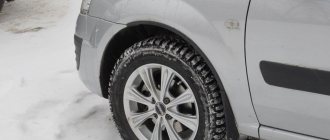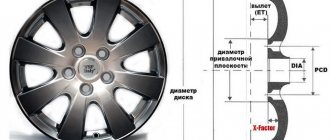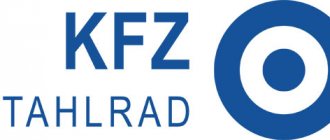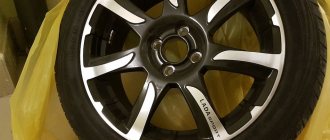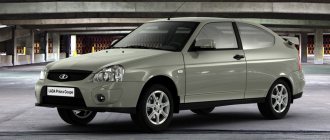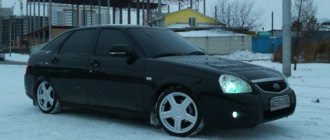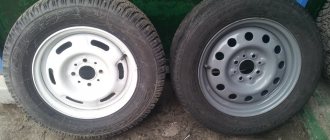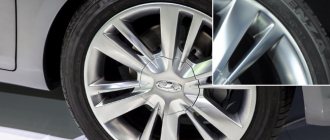Tire size for Moskvich 412
Fans of a sporty driving style with sharp acceleration and braking should choose wheels with a large number of thin spokes, which increases its rigidity with minimal weight.
The best characteristics are provided by two-part or three-part (consisting of two/three parts) prefabricated wheels. They allow you to combine different technologies (casting and forging) in the manufacture of individual parts: the rim and the central part of the disc. For Moskvich, alloy wheels can be selected without any problems. In this case, it is necessary to comply with some conditions - Muscovites are ideally suited for disks in which the mounting holes are located on a circle with a diameter of 115 mm (P C D), and the offset is 30 mm (ET). However, popular modern cars are not equipped with wheels of this size. The closest to these indicators are common disks with P C D equal to 114.3 mm. Japanese and Korean cars are equipped with such wheels, for example, some Mazda, Mitsubishi, Hyundai models.
The central hole of the Mazda 626 disk will have to be bored
The existing difference of 0.7 mm in the diameter of the circle where the fastening bolts are located can be neglected, since each hole is shifted relative to the center by 0.35 mm, which is compensated by the conical fit of the fastening nuts. If the wheel offset is greater - for example, 35 mm, it turns out to be recessed 5 mm into the depth of the arches, due to which the low Moskvich cutouts (at the rear) do not interfere with the normal rotation of the wheels. It is not recommended to use wider tires, since in this case the gap between the rear wheel and the spring on one side, as well as the wing on the other, will be unacceptably small. However, finding wheels less than 5.5 inches wide will not be easy, since five-stud hubs today are only equipped with heavy and powerful cars, which are not equipped with narrow wheels.
When purchasing and installing castings for a Moskvich, you must take into account that such disks, as a rule, have a large thickness in the mounting plane, so the length of the standard studs may not be enough and you will have to order extended ones from turners. In this case, the operation of fastening the disk should be treated more responsibly, strictly observing the sequence of tightening the nuts according to the star pattern. Discs with cylindrical rather than tapered holes may work without stud extensions because their special extended nuts allow the threads to be caught deep in the disc. However, their use is undesirable - problems with wheel alignment may arise.
Finally, you need to pay attention to the diameter of the hole for the hub in the disk - the DIA parameter. For original Muscovite wheels it is 74 mm, but for many alloy wheels it is less.
Due to the large thickness of the disc in the contact plane, extended mounting studs may be required
As a last resort, in order to seat the disc on the thickened part of the hub, you can chamfer the inside of the hole on the mating plane of the disc or bore the central hole on a machine.
Wheel size for AZLK 2141 Svyatogor
You need to move the wheels outward at least 10-12mm to avoid all problems. For the spacers I used 4mm thick aluminum sheets. There were three spacers for each wheel. The new wheel hub holes are too small to fit onto the front suspension hubs. I had to expand them in diameter by approximately 7-8mm with a grinder - to the required 75mm. After all these alterations, you can drive on new wheels, in my opinion, quite safely. By the way, in the photo in the front I have wheels from a Toyota Picnic, and in the back from a Mazda 626. They are very similar in appearance, but slightly different (the first have 14 slots in the disk, the second have 15). This is by the way.
Alloy wheels 5 x 115 for Moskvich
Here is a list of cars with a wheel hub pattern of 5 x 115, like a rear-wheel drive Moskvich. However, it should be taken into account that these wheels have an offset of 40 mm and that 14-inch wheels have a width of 6J and 15 and 16 inches have a width of 7J, which may mean friction of the wheel against the inner parts of the arches.
Wheels 5 x 115 come from front-wheel drive General Motors cars (but not all) and some models even have 2 bolt patterns (another 5 x 100) so it’s worth checking exactly when purchasing.
What kind of bolt pattern for Moskvich 412
I would like to install something like 175/80 R13. But I don’t know what wheels to buy for such tires. There are a lot of fights in our city and I think it will be possible to find them, it’s important to know what to look for. And another question: will it be possible to re-roll the previous, standard tires on them?
The catalog is incomplete but it was interesting to look at.
As for the tire size: standard wheels (with a rim width of 4.5 inches) can accommodate tires up to 185 wide (although this is too much, a maximum of 175 is better). So 175/80R13 can be safely installed on “original” wheels (by the way, for some time, instead of M-145, passenger Chizhi cars were equipped with M-154 tires - they are exactly 175 mm wide).
If you want to install any other disks, then the possible options here are:
I. Of the domestic ones - only VILS. At one time, a tiny batch of forged light-alloy wheels “Zvezda Rally” with holes for the Moskvich hub was produced (115/5 = 5 holes on a diameter of 115 mm). But this is a rarity, and IMHO it’s impossible to find them (although I saw them in Moscow, alas, on someone else’s car, not in a store).
II. From imported ones - what I tried myself. a) From BMW: they don’t even fit on the studs. b) From Mercedes: they fit on the studs, but the cones do not match, i.e. when tightening the nuts there will be problems with alignment. Although I saw (in Moscow) a luxury 2140 on Mercedes wheels with Volgov tires (205/70R14). The view is amazing! It turned out to be such a strong guy. Apparently, even such huge wheels have a place in Moskvich arches. There is one point here: wheels only from old Mercedes (123 body and earlier) are suitable, because the new ones (discs with round holes, like a jig-six) have a very long offset, and on a Muscovite, these wheels with the inner rim touch the handbrake cable guide at the rear and the steering knuckles at the front (checked). c) From American cars: as the salesman at the VILS brand store on Gorbunova Street (not far from the Kuntsevo market) told me, this is the best option. The “American” standard (I don’t know, however, whether all passenger cars have them - most likely, not all) - the mounting holes are located on a circle with a diameter of 4.5 inches, or 114.3 mm. This is, as they say, “our favorite size.” And in terms of offset, discs on American cars are doing better - it is smaller, i.e. the wheel protrudes outwards more => less chance of hitting internal parts. So you can try looking at advertisements for the sale of used spare parts for American cars (not necessarily those made in America. You can try from the same Ford Granada (they were made in Europe) - there seem to be 5 holes on the wheels).
PS: The seat size of the wheels does not have to be 13 inches. If you remember, at the very beginning the Muscovites were equipped with R15 tires, so IMHO you can install them up to this size and easily get rid of the screws. Although. Well, you yourself know everything about them.
Wheel size Moskvich 412
In my opinion, a huge amount of material has already been written about the installation of various kinds of non-original wheels on Moskvich 412 series. However, there is often still quite contradictory information regarding which wheels can be adapted for installation on a Moskvich, and for which it is not advisable to do this. It must be remembered that installing non-original (uncertified for it) wheels on a car is an illegal activity, and, in fairness, really unsafe. Therefore, if you really feel itchy (as, for example, I
) install other wheels, you need to at least approach such tuning responsibly.
I had three reasons for installing non-original wheels: 1. Potentially better characteristics of larger wheels (both in width and diameter) in terms of smoothness and directional stability. 2. Larger wheel diameter, which affects the speed characteristics of the car. 3. Appearance.
The last two motives are purely subjective and personally important to me. The choice initially settled on 14-inch wheels. I initially did not seriously consider the options for 15-inch wheels, because I think that this is too large a size for use on a Moskvich.
So, as you know, standard wheels have the following parameters: landing diameter - 13 inches rim flange width - 5 inches rim shape code - J number of studs x diameter on which they are located - 5 x 115mm offset - 30mm hub hole diameter - 74mm
The task, therefore, was to find the wheels that were closest in parameters, differing only in the landing diameter - 14 inches. Options for the wheels of Mercedes and BMW cars (including the “15”) are no longer available, since they have a stud diameter of 112 and 120 mm, respectively (at least for the common models known to me). You cannot install such wheels on Moskvich. A variant of wheels from Mazda 626, Xedox 6, Toyota HiAce, Toyota Picnic, etc. has appeared. One of the variants of wheel rims used on these cars has the following parameters:
33 advertisements found
Want to sell faster? Find out how
Moskvich wheels 2140/412/408! p13 100 gr.pcs total 5 pcs
Tires, rims and wheels » Wheels
100 UAH
Wheels Moskvich 2140.412. Ideal.
Tires, rims and wheels » Wheels
300 UAH
Wheels Moskvich 412
Tires, rims and wheels » Wheels
150 UAH
Kovpacks for Moskvich 412 chrome
Tires, rims and wheels » Caps
Guaranteed to receive the goods or money back to the card More details.
450 UAH
chrome cap USSR Moskvich-412
Tires, rims and wheels » Caps
300 UAH
Krivoy Rog, Central City March 14
Tires for Moskvich 412 and 2140
Tires, rims and wheels » Tires
500 UAH
Kyiv, Svyatoshinsky March 13
Wheels Moskvich IZh Azlk 408, 412, 2140, 2141
Tires, rims and wheels » Wheels
200 UAH
Selling hub caps Moskvich 2140 lux, 412, etc.
Tires, rims and wheels » Caps
150 UAH
Wheel for Moskvich 412
Tires, rims and wheels » Tires
700 UAH
Kharkov, Industrialny 13 March
Selling chrome caps for Muscovite IZH-412
Tires, rims and wheels » Caps
200 UAH
Moskvich 412 caps
Tires, rims and wheels » Caps
200 UAH
Wheels Moskvich 2140 412 13 5 114.3
Tires, rims and wheels » Wheels
100 UAH
Wheels Moskvich 412 2140 408
Tires, rims and wheels » Complete wheels
200 UAH
Krivoy Rog, Zhovtnevy March 9
Wheels Moskvich IZh Azlk 408, 412, 2140, 2141, trailer
Tires, rims and wheels » Wheels
250 UAH
Wheels Moskvich 408, 412, 2140
Tires, rims and wheels » Wheels
100 UAH
Zaporozhye, Voznesenovsky 6 March
Steel wheel R14 Volga 2410, 31029, R13 Moskvich 412
Tires, rims and wheels » Wheels
100 UAH
Selling wheel cap for Moskvich 2140, 412. Chrome.
Tires, rims and wheels » Caps
200 UAH
Tires m 145 for Moskvich 408,412,434,426,2715
Tires, rims and wheels » Tires
850 UAH
wheels Moskvich M408-412-2140
Tires, rims and wheels » Wheels
100 UAH
Wheels for classic Moskvich 412/2140/2125
Tires, rims and wheels » Wheels
150 UAH
Moskvich cap 412 chrome
Tires, rims and wheels » Caps
Guaranteed to receive the goods or money back to the card More details.
200 UAH
Zaporozhye, Shevchenkovsky 28 Feb.
Tire for Moskvich 412- 1 piece r 13
Tires, rims and wheels » Tires
150 UAH
Hub caps, chrome caps Moskvich 2140,412,408,IZH,AZLK
Tires, rims and wheels » Caps
450 UAH
Kharkov, Kholodnogorsky 26 Feb.
False disks, false disks, caps Moskvich 2140,412,408
Tires, rims and wheels » Caps
1 100 UAH
Kropivnitsky, Kirovsky district February 25.
Shock absorbers USSR MoskvichAZLK 412 + polyurethane bushings
Tires, rims and wheels » Tires
450 UAH
Selling wheels for Moskvich 412. 2140.
Tires, rims and wheels » Wheels
100 UAH
Wheels Moskvich 412 tires R14 pair 100 UAH
Tires, rims and wheels » Complete wheels
75 UAH
disk for Moskvich 412
Tires, rims and wheels » Wheels
300 UAH
Kharkov, Chervonozavodskoy 23 Feb.
Discs
0
Tracing its pedigree from Opel, the Moskvich model 400/401 was equipped with narrow 4.50-16 or 5.00-16 tires. Today, such “shoes” are of interest only to restorers. However, it was radically different from other cars of those years in the design of its wheels: the cast-iron brake drum simultaneously served as both the hub and the wheel disk, and the mounting studs were spaced apart to the maximum possible diameter. Therefore, the wheel was actually devoid of a hub and consisted only of a rim with sockets for fastening nuts. The entire structure was covered with a convex chrome cap. Starting with the 402 model, there was a transition to a smaller diameter, and the seat of the wheel on the hub did not subsequently change for Muscovites until the advent of the front-wheel drive model 2141! This means that “theoretically” any wheel from any rear-wheel drive Moskvich starting from 402 can be installed on any Moskvich up to the late 2140. In practice, a disc brake caliper will prevent this.
0
0
0
0
0
True, the rim of models 402, 403, 407 and 410 had a diameter of 15 inches, and on later models (408, 412, 2140, etc.) a 13-inch one was used - according to the fashion of that time, the outer diameter of the disk (and tire ) gradually decreased, and the profile width, on the contrary, increased. An interesting point: wheel rims for Muscovites were produced by two factories - GAZ and VAZ, and the wheel with an asymmetrical rim profile for Muscovites, produced at VAZ, differs from the corresponding part for Zhiguli only in the number of holes for bolts and the shape of the hub stamp, and the rim itself is exactly the same!
0
Until 1970, 4J-13 wheels were installed on sedans, and rims increased to 4 ½ inches in width were used on station wagons and vans. After 1970, all cars were equipped with wider wheels. Disks with a symmetrical rim produced by GAZ can be easily distinguished by four ventilation windows, and since 1973, new disks with an asymmetrical rim profile and six oval ventilation holes began to be installed on all Muscovites. In 1980-1981, wheels of the same type, but with a rim width of 5J, were produced by the GAZ plant. Discs with symmetrical rims can only be used on Moskvich vehicles with drum brakes on all wheels.
0
Since 1982, Moskvich wheels have been produced without three protrusions for attaching the wheel cap. Since the chrome part that covered the entire central part was eliminated, small caps appeared in the central hole instead; on the AZLK-2140 “Lux” model, the hub was covered with plastic caps, “fashionable” at that time, fastened with wheel nuts.
0
Moskvich-2140
0
0
The front-wheel drive Moskvich model 2141 had its own wheels with original parameters. They differed in both the rim diameter (14 inches) and the number of mounting holes (four instead of five). In terms of the bolt-to-bolt distance (4 x 108 mm), the 5J wide wheels with an offset of 45 mm were identical to the Audi part.
Tire size for Moskvich 412
In 1964, when the Moskvich-408 first entered the production line, it was clear that its engine, which traces its origin back to the 1938 Opel Kadett, was at the limit of its ability to improve. The rugged and heavy Moskvich needed a very powerful engine to meet at least the average Western standard. In the same year, designers began working on a new engine - for the first time in the history of the plant. And they were inspired by the German BMW M10 unit.
Moskvich-412 – video test drive
Muscovites did not copy the Bavarians - they only adopted a number of advanced solutions. An aluminum cylinder block, hemispherical combustion chambers, and an overhead camshaft with a chain drive provided advanced, by world standards, power output. Thanks to replaceable cylinder liners, during a major overhaul the engine did not need to be bored using complex equipment—it was enough to just replace the liners. The full bearing crankshaft ensured smooth operation and low noise. In addition, the engine had an unusual layout with an inclined cylinder block for compactness and a lower center of gravity.
For the first time in the USSR, this engine was equipped with a quick-change air filter, which every car now has. The engine design was fine-tuned on the Moskvich-G4 M racing car. Master of Sports V. Shchavelev took 4th place in it at the 1966 USSR Championship in circuit racing. The Moskvich-412 car was not a replacement for the Moskvich-408, but a slightly belated luxury version. Compared to the basic version, acceleration, efficiency, and top speed have improved. Moskvich-412 remained the fastest production Soviet car until the appearance of the VAZ-2103 in 1972.
Moreover, MZMA's developments in the field of engine building influenced the work of the new Volzhsky Automobile Plant. At the insistence of Moscow engineers, who were involved in the evaluation and modernization of the Fiat 124 (the future VAZ-2101), Fiat agreed to rework the engine from a lower camshaft to an upper one, that is, to modernize it. A more powerful engine required changes to other components of the Moskvich-412 compared to the 408. For the first time in the USSR, the 412th had a gearbox with a floor lever and synchronizers on all four stages, and a hydraulic vacuum brake booster.
There was a catastrophic shortage of “Muscovites”, so since 1967 their production was also mastered at. Since that time, the evolution of the model has proceeded independently in Moscow and Izhevsk. For example, it was believed that Izhevsk “Moskvich” cars had a higher build quality. But the Moscow “Moskvich-408” and “Moskvich-412” were modernized in 1969 to meet European safety requirements, receiving a new body with a different power structure, a safety steering column, separate front seats, seat belts, soft interior trim, and a rear mirror view with night mode and other improvements. At the same time, rectangular headlights of European standard began to be installed on Moskvich. It must be said that VAZ introduced similar headlights only in 1979.
Moskvich-412 became the first Soviet car to pass a crash test in France. Not only VAZ, but also MZMA/AZLK widely used foreign developments. Thus, the Moskvich-412 had a licensed clutch with a diaphragm spring (for the first time in the USSR) and a brake system developed in England. Moreover, in the early 1970s. Both AZLK and Izhmash were completely rebuilt to Renault assembly technologies, after which they reached a capacity of up to 200 thousand units. per year each. Until the mid-1970s. Moskvich-412 sold well all over the world, not least due to its sporting fame. Sales increased sharply after the 1968 London-Sydney rally, in which the Soviet car showed its reliability. The success of the Moskvich is primarily associated with a reliable and unpretentious design with a large margin of safety. Moskvich-412 became the last car from the USSR to achieve success in world sports.
The model was produced at AZLK until 1976 and came off the assembly line almost simultaneously with the “junior” Moskvich-408. By this time, the car had lost ground both in sports and in exports. Over the years, foreign dealers made more and more of their own modifications to make Soviet cars meet the requirements. As for Izhmash, which worked mainly for the domestic market of the country, it produced its version of the 412 until 1994.
Small class passenger cars are produced by the IZHMASH production association: Moskvich-412IE since 1967, IZH-21251 since 1982. The body is closed and load-bearing. Moskvich-412IE is a four-door sedan, IZH-21251 is a five-door combi. The front seats are adjustable in length and backrest tilt, with headrests, folding backrests, the rear seat of the Moskvich-412IE is fixed, in the IZH-21251 it folds to increase the luggage compartment.
Engine.
Maud. 412E and 412DE, gasoline, in-line, 4-cyl., 82×70 mm, 1.48 l, operating order 1-3-4-2, carburetor DA-AZ-2140. Mod.412E and 412Yu: compression ratio 8.5; power 54.0 kW (73.5 hp) at 5800 rpm; torque 105.8 N*m (10.8 kgf*m) at 3000-3800 rpm. Mod.412DE and 412DU: compression ratio - 7.2; power 49.0 kW (66.6 hp) at 5800 rpm; torque 102.0 N*m (10.4 kgf*m) at 3000-3800 rpm.
Transmission.
The clutch is single-plate, with a diaphragm spring, the release drive is hydraulic. Gearbox - 4-speed, gear. numbers: I-3.49; II-2.04; III-1.33; IV-1.00; ZX-3.39. Synchronizers - in 1st-4th gears. Cardan transmission - one cardan shaft. The main gear is hypoid, gear. number - 3.91.
Wheels and tires.
Wheels - disc 4 1/2J-13. Fastening - on 5 studs. Tires - 165/80R13 or 165-13 (6.45-13), mod. MI-166, Ya370 or M-145. Front tire pressure 1.7; rear - 2.0 kg/cm. sq., Number of wheels 4 + 1.
Suspension.
The front is independent, on wishbones with coil springs, shock absorbers and anti-roll bar. The rear is dependent, on longitudinal semi-elliptic springs with shock absorbers.
Brakes.
Working brake system: front brakes - disc, rear - drum with automatic clearance adjustment. Drive - hydraulic, dual-circuit, with a hydraulic vacuum booster and brake force regulator, Parking brake - with a mechanical drive to the rear brake mechanisms, Spare brake - one of the circuits of the service brake system.
Steering.
The steering mechanism is a globoidal worm with a double-ridge roller, gear. number 16.12.
Electrical equipment.
Voltage 12 V, ac. battery 6ST-55AZ, alternator 58.3701 alternating current, with built-in rectifier and relay regulator, starter ST117-A, distributor R147-A for engines 412E and R147-B for engines 412DE, ignition coil B115-V, spark plugs A20-D1 for engines 412E and A17-D - for 412DE engines.
Filling volumes and recommended operating materials.
Fuel tank - 46 l, AI-93 gasoline for the 412E engine and A-76 for the 412DE; cooling system 10.3 l, antifreeze A-40; engine lubrication system - 5.2 l, oils in summer M-12G, in winter - M-8G all-season M-6/10G, M-8V; steering gear housing 0.1 6 l, TAD-17I; gearbox housing - 0.9 l, TAD-17I; drive axle housing 1.3 l, TAD-17I; brake drive system 0.55 l, brake fluid “Neva”, “Tom”; front shock absorbers 2×0.135 l, rear shock absorbers - 2×0.225 l, shock absorber fluid AZh-12T; windshield washer reservoir - 1.9 l, NIISS-4 liquid mixed with. water.
Weight of units (in kg):
Engine with equipment and gearbox - 166, clutch assembly - 11, gearbox assembly - 22, front suspension assembly - 80, rear suspension with axle - 87, rear axle - 55, body assembly - 400.
SPECIFICATIONS
| Model | 412IE | IZH-21251 |
| Number of seats, persons | 5 | 5 |
| Luggage weight, kg | 50 | 50 |
| Curb weight, kg | 1000 | 1040 |
| Including: | ||
| to the front axle | 540 | 535 |
| to the rear axle | 460 | 505 |
| Total weight, kg | 1400 | 1400 |
| Including: | ||
| to the front axle | 630 | 635 |
| to the rear axle | 770 | 805 |
| Weight of roof rack with cargo, kg | 60 | 60 |
| Permissible trailer weight (without brakes), kg | 300 | 300 |
| Max speed, km/h | 142(132) | 142(132) |
| Acceleration time to 100 km/h, s | 19(20) | 19(21) |
| Max climbability, % | 28 | 28 |
| Coasting from 50 km/h, m | 450 | 450 |
| Braking distance from 80 km/h, m | 43,2 | 43,2 |
| Control fuel consumption, l/100 km: | ||
| at 90 km/h | 7,4(7,8) | 7,8(8,2) |
| at 120km/h | 10,2(10,6) | 10,6(11,1) |
| urban cycle | 10,3(10,8) | 10,5(1 1,0) |
| Turning radius, m: | ||
| on the outer wheel | 5,25 | 5,25 |
